Trying to State the Texas Jobs Issue as Simply as Possible
What's the bottom line in the Texas jobs discussion?
 Much of the discussion flying about on the issue of jobs in Texas appears to missing the fundamental point, which boils down to this: does Texas provide a model that could be replicated at the national level?
Much of the discussion flying about on the issue of jobs in Texas appears to missing the fundamental point, which boils down to this: does Texas provide a model that could be replicated at the national level?
This strikes as a reasonable question that is not ideological in orientation nor does it comment on Perry’s suitability for nomination (although the answer to the question does help or hinder him, politically speaking). However, I have noted in the comments on previous posts on this topic that many have already picked their sides and really are not interested in asking serious questions with serious answers.
If there is a model in Texas that is actually exportable to a national policy, I am more than pleased to hear about it, given the clear need for employment in this country.
However, if the “Texas Miracle” is not an actual model (or, for that matter, even a miracle), then that is important to understand as well.
The best interpretation of the Texas jobs situation is that because it is a low tax, low regulation state (Perry’s fundamental claim) it has therefore been able to attract companies to move from other states to Texas. It is also true that Texas has relatively low cost of living as a general proposition (certainly better than places like California or New York). Lower cost of living means that a company can pay less than it would have elsewhere. There is a positive business climate in Texas (and I certainly have never argued otherwise).
This raises a question, however: is the process described above what has actually happened? My initial predilection was to assume that a lot of what has happened in Texas jobs-wise was similar to what I saw when I lived in Austin in the 1990s: the relocation of businesses from more expensive states (e.g., California) to less expensive Texas. There were a number of high tech firms that relocated to Austin from Silicon Valley during that time, for example (and indeed, as a side note, this basic dynamic has been going on for over two decades, so the degree to which Perry can claim special credit is dubious).
Ok, so the issue becomes twofold: 1) is that what has been happening of late? and 2) if so, is this a viable national model in some way?
Let’s hold off on the first question and assume for the sake of argument that low-tax, low-regulation Texas is siphoning jobs from elsewhere in the country: is that something that can be used as a national jobs policy? Clearly, it cannot.
To wit: the US economy’s ability to play that game on the international stage is quite different than it is for a state to play within the confines of the US. A very simple observation: on the international stage we already know that for many manufacturing jobs the US does not have comparative advantage in terms of wages. The only way, for example, to lure textile plants back from El Salvador, or to bring iPhone assembly (or any number of other examples) from China to the US would be via highly depressed wages and/or far higher prices for consumer goods (among other issues). This is not going to happen (nor would we want it to). As such, I am not sure what the Texas Model tells us in terms of job creation.
But let’s go back to the first question: are we seeing a substantial number of businesses moving to Texas and is that where the new jobs are coming from? A piece in the Atlantic would suggest that perhaps this is less the case than I (and others) are assuming. To dovetail with some data I noted the other day, Derek Thompson notes (see graph below) that the largest areas of job growth in Texas are largely in areas like government and education/health services–jobs linked to population growth, not a new and unique economic engine. This is because as your population grows, you need more teachers (for example) and hence you get job growth in the education sector. To quote again from the WSJ, “Employment in the state’s public sector has jumped 19% since 2000, compared with a 9% rise in the private sector.” In other words, the lion’s share of the job creation in the state has been government jobs. And yet, somehow I do not think that what Perry is preaching from the campaign stump is that he wants to go to Washington to hire more government employees (indeed, he is saying no such thing).

If you go over to the piece as linked above, you will see that the general jobs profile of Texas and the US are actually quite similar, with the main exception of Texas growing in government employees (while the country as a whole is shrinking in that sector) as well as in “leisure and hospitality” with some small growth in “other services” and “professional and business services.”
Let me be clear: I agree that the Texas economy has been healthier than some other parts of our economy. I just am not seeing some unique policy in operation there, but I am especially not seeing something that would work on the national level. As such, I am not sure Perry can legitimately claim to have the solution to the country’s job problems (at least not based on the claim that if the US does what Texas has done, then there will be more jobs).
A concluding thought on the notion that taking Texas’ policies and moving them to the other 49 states: that isn’t something that the President of the United States can do in any event, so it becomes increasing unclear what Perry is actually offering.

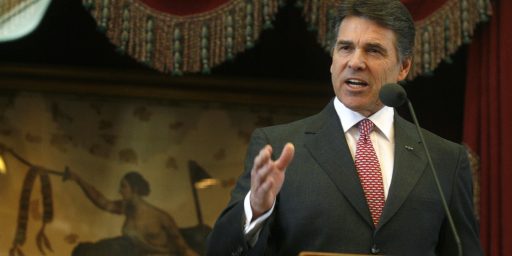
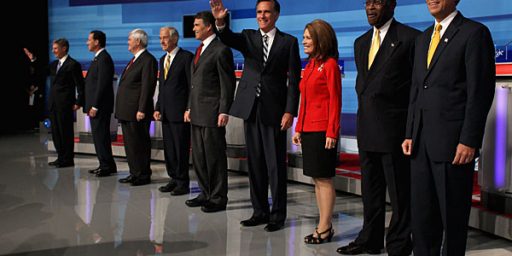
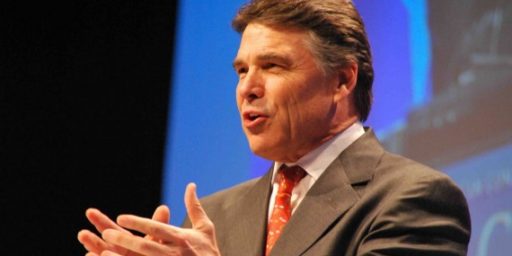
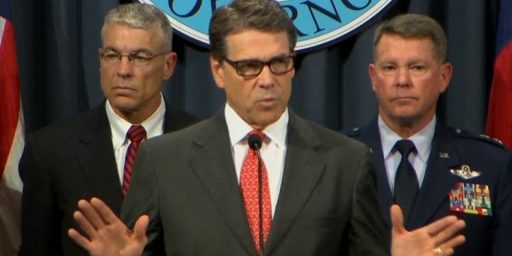
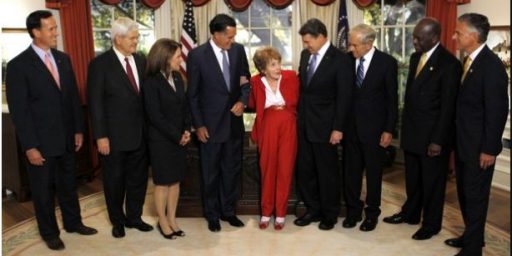
Well…the one thing that can be replicated nationwide is to STOP FIRING GOVERNMENT EMPLOYEES.
Texas is growing it’s public sector – in direct contradiction to what Rick-the-Apostle says about small government.
Nationwide we are shrinking our public sector. We have shed about 1/2 a million public sector jobs, while adding around 2 million private sector jobs. Add back in that 1/2 million jobs, as the Teavangelical is doing in Texas, and the recovery is looking a lot rosier. 25% rosier +/-. 1/2 million more people spending money means more growth.
But SHRINKING THE GOVERNMENT is what the so-called Republicans asked for. So I fail to see why they complain about the economy—unless they are just not smart enough to know what it is they are asking for. Maybe a miracle? Like the pretend miracle in Texas?
If low taxes and few regulations are the key to economic success, why hasn’t Texas been our leading economic power for the last 40 years? They start with the built in advantage of an energy sector that most states do not have, which means that just average growth in other sectors should place them way ahead of the rest of the country. Why did it take the recession to create the, apparent, divergence we now see? Is it really low taxes, or a state less affected by the real estate bust? Will this disappear when the economy improves?
I have major qualms about this as our future model for the country. I dont see how we remain competitive on an international level with the lowest high school graduation rate in the country and so few people with health insurance. Texas can import the educated class it needs. If we are all Texas, where do they come from?
Steve
This is easily one of the dumbest lines ever posted on this website: “Employment in the state’s public sector has jumped 19% since 2000, compared with a 9% rise in the private sector. In other words, the lion’s share of the job creation in the state has been government jobs.”
WRONG.
The vast majority of the added Texas jobs are private sector jobs. The public sector is tiny but adding new 1200 people a day in Texas caused a need for a lot of new teachers. The vast bulk of new public sector jobs in Texas are teaching jobs due to its roaring growth. Remember, Texas is adding four new Congressional seats because of its explosive growth. Also keep in mind that Texas government spending tracked right along with population growth plus inflation.
The private sector, meanwhile, is much, much larger than the public sector in Texas. The lion’s share of new jobs in Texas are private sector jobs. The growth has been broad-based, in a variety of industries and at a variety of wage levels. Oil and gas is a part of it, sure, but financial services, aerospace, and other industries saw the greatest job growth BY FAR in Texas
Texas has added nearly 4 times more net private sector jobs since June 2006 than all other job-adding states combined (78% of all new private sector jobs among those net positive states). It actually looks more lopsided if you figure that many states lost jobs over this period of time.
The explosive growth in Texas, plus the fact that Texans are still having children (unlike much of the rest of the country) created a need for a teachers. Take away the teachers, and Texas’ public sector growth was negligible. Again, Texas spending is basically flat after accounting for inflation and population growth.
My advice to you. Learn how percentages work. If you take 19% of an apple versus 9% of an apple tree, the 9% of the apple tree is going to be much larger than the 19% of the single apple. Duh.
Perry’s economics – in order to compete with 3rd world countries we have to become a 3rd world country.
Harold Meyerson:
Lower taxes and regulation aren’t something that would generate significant job creation on a national scale, as those aren’t the problems. Businesses are struggling because we’re in a balance sheet recession and everyone is paying down debt instead of spending. Debt is hurting the economy and until it is addressed job creation and GDP growth will continue to be weak.
It would be swell if Texas Fact Checker included some links or…I don’t know…some facts?
or
may be true, but it’s hard to judge.
Thanks for linking to the WSJ article. My main concern with the Derek Thompson post was that 2007-2011 is a relatively short and unusual period of time, and the jobs that grew in that period might simply be more resistant to a recession than other sectors. It turns out that the entire decade of job growth in Texas was dominated by Mining, Health Care & Private Education, and Government Employment. Less than 100,000 net jobs were in other categories.
Why do they group “Health Services” with ‘Private Education” in a single category? Particularly since “Private Education” is different from Public Sector Education employment, or so the WSJ article said.
@Texas Fact Checker
Read the WSJ article. It points out that out of the roughly “more than a million” net jobs created in Texas since 2000, roughly 952,000 of them were created in 1)Education and Health Services, 2)Government, and 3)”Mining”. Unless it’s a LOT more than “a million” (which I doubt), less than 100,000 net jobs were created in other sectors. Aerospace and Financial Services might be thriving there, but they’re not creating many jobs.
As for “private sector” jobs, the “Education & Health Services” category exists in a gray area. Most of the jobs are in the Private Sector, but significant percentages of the consumer demand in that sector come from government payments, particularly Medicare, Medicaid, and so forth.
On the bright side, the median wage in Texas in $15.14 an hour. Pre-tax, that’s roughly $32,000 a year before tax. Not so great on a single income, but two-income families at that rate could do okay. Even a single-income family on that might be alright if costs of living are sufficiently low (and they are unusually low in Texas).
Correction: I think my numbers on the “Mining” sector jobs are wrong. The WSJ is confusing – is 243,000 the number of jobs in the sector, or the net increase in jobs in the Mining Sector?
It sounds like the “94,000” number might be more accurate, but then they show a chart that doesn’t fit with either estimate.
@Brett:
If that were the average wage it would be pretty good – as a median wage it is not. Median is the half way point between the highest and lowest wage and there are some in TX that make a lot of money.
One of the things worth noting on Thompson’s chart is how much smaller the losses were in other sectors, perhaps allowing some of service sectors to flourish. Since “jobs created” is actually jobs created minus jobs lost, both sides of the ledger are important.
Is there anything reproducible on a national scale? Here are some possibilities:
1) While the US isn’t going to be luring jobs from third-world overseas, it’s possible that the Texas model could prove superior in stopping or (less unlikely) slowing the bleeding. If true, this would represent a philosophical question, is it worth holding onto the jobs if they pay less? Is that glass half-full or half-empty?
2) Exploit what natural resources you have.
3) Large-scale immigration does not, in itself, create large amounts of unemployment (looking at Nevada, California, and to a lesser extent Florida and Arizona might make one wonder). However, low wages may play a role in this.
4) Paying public-sector employees less and offering less benefits for them may allow you to employ more of them for less money.
5) Screw the information sector. Wait. What? I don’t like that one at all.
@Brett:
@Trumwill: The numbers I was using in the other post was the official unemployment numbers. Google has a nice interactive graph.
Considering that there is only three data points for the population (the censuses), and that the unemployment numbers are based on sampling, I think using those to try to say anything about the average rate or the rate pre recession might introduce a lot of errors.
@Ron Beasley: No, that’s not what median wage is. The median wage is the wage that the middle employee makes. It doesn’t matter how much the highest income person makes or how little the lowest income person does. It’s what the middle makes.
The median of 1,3,5,7,9 is 5.
The median of 1,2,5,6,6 is 5. The mode (sum/records) is four. The half-way between minimum and maximum is 3.5.
That’s an awesome link, PJ. Thanks.
Texas has fewer zoning restrictions, right? People who live there see the plus and minus of it, but it is one factor that could be replicated for lower housing costs.
(I’m not sure people should go as low as Texas, but another part of my mind wonders if there should be no minimum lot size, or housing size, allowed. California would be much more space efficient with rampant subdivision.)
Haha, while correcting Ron’s error, I made my own. Sum/Records=Mean, not Mode.
Now there is also one thing that needs to be said:
Looks like a majority of the jobs were also created via federal stimulus spending.
Check out the info at http://tpmdc.talkingpointsmemo.com/2011/08/chart-of-the-day-government-jobs-led-to-perrys-economic-boom.php
Texas Miracle recovery? Thanks, Obama!
@Bubba: @Bubba: which is interesting, since less stimulus was spent in Texas (per capita) than every other state but two. Texas really must have done more with less, in that respect. Rick Perry is a heck of a governor.
(No, I’m not serious about that, but it’s no less flawed an argument than Bubba’s.)
Not true. There are any number of other ways. Wages in China could rise (already happening). Productivity of labor in the U. S. could increase (also happening).
China could stop buying Treasuries and start using the dollars they accumulate to purchase U. S. goods and services, i.e. comparative advantage would start working in our favor. There are all sorts of ways.
@Dave Schuler: How likely is it that the jobs would come back, as opposed to, say, moving from China to Thailand?
@Dave Schuler:
We don’t let China buy much with their dollars, certainly not assets of significant value.
@Dave Schuler: But those aren’t policy (i.e., “ways to lure”) that can be enacted by the US government (which is the point I am trying to make).
Selling Treasuries to the Chinese government isn’t a policy?
@Dave Schuler: Well, you said:
That’s policy, yes, but Chinese policy. I was focused on US policy.
@Trumwill:
Jobs move from China to
Charlotte
Wichita
Milwaukee
I’m not claiming that manufacturing jobs haven’t moved to China over the last 30 years. Obviously, they have. But it’s more complex than just the lowest possible wage. That’s a misunderstanding and a mistake. You’ve got to consider productivity differences and comparative advantage, just to name two factors.
But it’s more complex than just the lowest possible wage. That’s a misunderstanding and a mistake. You’ve got to consider productivity differences and comparative advantage, just to name two factors.
On that we agree, which is why I am skeptical of claims that everything is going to be outsourced. I’d hoped that the raising wages in China would make the bleeding stop. I didn’t think that we would actually be able to bring them back. Not the manufacturing ones, anyway. That’s awesome. Thanks for sharing.
Politcal Math has one of the most comprehensive analyses of job growth in Texas that I’ve seen so far. It was posted yesterday.
http://www.politicalmathblog.com/
This guy is no fan of Rick Perry, but he says the Texas Economic Miracle is real.
@Moderate Mom: In looking over his post, however, it would seem to that his answer to the following:
Would be “no.”
(And that is the bottom line I am trying to get at in this post).
I agree with those above who say the wage differential is sufficient to explain jobs flow, and that taxes and regulations pale in comparison This is 2006 data, but you could double the Chinese wage without much impact:
When you have to move Chinese wages up 10x or something, basically you have something that’s not going to happen. Chinese won’t get that prosperous for decades and even correcting the exchange dynamics isn’t going to move it that far.
You want change? You need tariffs, with all their disadvantages.
A 2010 story has wages “up” to $300/month. Using the hour/month ratio above, that puts the wage at about $1.50/hr.
YIKES! Invictus schools us on The Texas “Miracle”
A big factor is TX has tighter regulations of mortgage loans. These can be replicated on a national scale. See details here:
http://rortybomb.wordpress.com/2011/08/18/investigating-the-link-between-debt-deleveraging-and-the-texas-miracle/
Okay, so basically the job creation is because of population growth, got it. So why is the population growing? Is it the balmy Texas climate (108 degrees in Austin yesterday), or is it a political climate that doesn’t stifle bussiness?